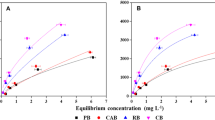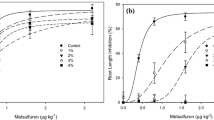Abstract
Burning straw in the field is a common agricultural practice. The effects of adding biochar derived from rice straw to soils on the phytotoxicity of sulfentrazone to Oryza sativa L. were observed. Overall, when 1 % biochar was added to three different soils, the phytotoxicity of sulfentrazone to O. sativa L. decreased, and the concentration that inhibits growth by 50 % (IC50) increased by 1.4 to 7.6 times. To illuminate the influencing mechanisms, the changes in sulfentrazone adsorption to the soil, the soil pH, and the bioavailable sulfentrazone extracted from the soil solution using hollow fiber-based liquid-phase microextraction were studied. The Freundlich constant (K f ) of sulfentrazone to the soil increased 1.5 to 25 times relative to the K f in the three unamended soils, and the soil pH increased by 0.36 to 1.36 units resulted in a fraction of dissociated sulfentrazone increased by 10.2–17.4 %. In addition, the average concentrations of sulfentrazone in the three unamended soil solutions were 1.3–6.1 times relative to those in the three biochar-amended soil solutions. These results suggest that the sulfentrazone adsorption and soil pH increased when soils were amended with biochar, which decreased the bioavailable concentrations and reduced its phytotoxicity to O. sativa L.



Similar content being viewed by others
References
Anskjær GG, Rendal C, Kusk KO (2013) Effect of pH on the toxicity and bioconcentration of sulfadiazine on Daphnia magna. Chemosphere 91:1183–1188
Boström ML, Berglund O (2015) Influence of pH-dependent aquatic toxicity of ionizable pharmaceuticals on risk assessments over environmental pH ranges. Water Res 72:154–161
Cao GL, Zhang XY, Wang YQ, Zheng FC (2008) Estimation of emissions from field burning of crop straw in China. Chin Sci Bull 53:784–790
Chang CH, Liu CC, Tseng PY (2013) Emissions inventory for rice straw open burning in Taiwan based on burned area classification and mapping using FORMOSAT-2 satellite imagery. Aerosol Air Qual Res 13:474–487
Chen S, Ke RH, Zha JM, Wang ZJ, Khan SU (2008) Influence of humic acid on bioavailability and toxicity of benzo[k]fluoranthene to Japanese medaka. Environ Sci Technol 42:9431–9436
Ferrell JA, Witt WW, Vencill WK (2003) Sulfentrazone absorption by plant roots increases as soil or solution pH decreases. Weed Sci 51:826–830
Ghambarian M, Yamini Y, Esrafili A (2012) Developments in hollow fiber based liquid-phase microextraction: principles and applications. Microchim Acta 177:271–294
Graber ER, Tsechansky L, Gerstl Z, Lew B (2012) High surface area biochar negatively impacts herbicide efficacy. Plant Soil 353:95–106
Grey TL, Walker RH, Hancock HG (1997) Sulfentrazone adsorption and mobility as affected by soil and pH. Weed Sci 45:733–738
Hu X, Liu J, Jonsson JA, Jiang G (2009) Development of negligible depletion hollow fiber-protected liquid-phase microextraction for sensing freely dissolved triazines. Environ Toxicol Chem 28:231–238
Jiang J, Xu RK, Jiang TY, Li Z (2012) Immobilization of Cu(II), Pb(II) and Cd(II) by the addition of rice straw derived biochar to a simulated polluted Ultisol. J Hazard Mater 229–230:145–150
Kah M, Brown CD (2006) Adsorption of ionisable pesticides in soils. Rev Environ Contam Toxicol 188:149–217
Khorram MS, Wang Y, Jin XX, Fang H, Yu YL (2015) Reduced mobility of fomesafen through enhanced adsorption in biochar-amended soil. Environ Toxicol Chem 34:1258–1266
Lehndorff E, Roth PJ, Cao ZH, Amelung W (2014) Black carbon accrual during 2000 years of paddy-rice and non-paddy cropping in the Yangtze River Delta, China. Glob Chang Biol 20:1968–1978
Li TQ, Han X, Liang CF, Shohag MJI, Yang XE (2015) Sorption of sulphamethoxazole by the biochars derived from rice straw and alligator flag. Environ Technol 36:245–253
Liu JC, Tzou YM, Lu YH, Wu JT, Cheng MP, Wang SL (2010) Enhanced chlorophenol sorption of soils by rice-straw-ash amendment. J Hazard Mater 177:692–696
Liu J, Jönsson JÅ, Mayer P (2005) Equilibrium sampling through membranes of freely dissolved chlorophenols in water samples with hollow fiber supported liquid membrane. Anal Chem 77:4800–4809
Nag SK, Kookana R, Smith L, Krull E, Macdonald LM, Gill G (2011) Poor efficacy of herbicides in biochar-amended soils as affected by their chemistry and mode of action. Chemosphere 84:1572–1577
Neuwoehner J, Escher BI (2011) The pH-dependent toxicity of basic pharmaceuticals in the green algae Scenedesmus vacuolatus can be explained with a toxicokinetic ion-trapping model. Aquat Toxicol 101:266–275
OECD (2000) OECD Guideline 106-OECD Guideline for the testing of chemicals: adsorption-desorption using a batch equilibrium method. France, Paris
Ohmes GA, Mueller TC (2007) Sulfentrazone adsorption and mobility in surface soil of the southern United States. Weed Technol 21:796–800
Oleszczuk P, Zielińska A, Cornelissen G (2014) Stabilization of sewage sludge by different biochars towards reducing freely dissolved polycyclic aromatic hydrocarbons (PAHs) content. Bioresour Technol 156:139–145
Passos ABRJ, Freitas MAM, Torres LG, Silva AA, Queiroz MELR, Lima CF (2013) Sorption and desorption of sulfentrazone in Brazilian soils. J Environ Sci Health B 48:646–650
Sijm D, Kraaij R, Belfroid A (2000) Bioavailability in soil or sediment: exposure of different organisms and approaches to study it. Environ Pollut 108:113–119
Sopena F, Semple K, Sohi S, Bending G (2012) Assessing the chemical and biological accessibility of the herbicide isoproturon in soil amended with biochar. Chemosphere 88:77–83
Stan V, Fintineru G, Mihalache M (2014) Multicriteria analysis of the effects of field burning crop residues. Not Bot Horti Agrobo 42:255–262
Szmigielski AM, Schoenau JJ, Johnson EN, Holm FA, Sapsford KL, Liu JX (2009) Development of a laboratory bioassay and effect of soil properties on sulfentrazone phytotoxicity in soil. Weed Technol 23:486–491
Tao Y, Liu JF, Hu XL, Li HC, Wang T, Jiang GB (2009) Hollow fiber supported ionic liquid membrane microextraction for determination of sulfonamides in environmental water samples by high-performance liquid chromatography. J Chromatogr A 1216:6259–6266
Tatarkova V, Hiller E, Vaculik M (2013) Impact of wheat straw biochar addition to soil on the sorption, leaching, dissipation of the herbicide (4-chloro-2-methylphenoxy)acetic acid and the growth of sunflower (Helianthus annuus L.). Ecotoxicol Environ Saf 92:215–221
Ter Laak TL, Agbo SO, Barendregt A, Hermens JLM (2006) Freely dissolved concentrations of PAHs in soil pore water: measurements via solid-phase extraction and consequences for soil tests. Environ Sci Technol 40:1307–1313
Xiao X, Li F, Huang J, Sheng GD, Qiu Y (2012) Reduced adsorption of propanil to black carbon: effect of dissolved organic matter loading mode and molecule size. Environ Toxicol Chem 31:1187–1193
Xing L, Liu H, Giesy JP, Yu H (2012) pH-dependent aquatic criteria for 2,4-dichlorophenol, 2,4,6-trichlorophenol and pentachlorophenol. Sci Total Environ 441:125–131
Yang YN, Sheng GY, Huang MS (2006) Bioavailability of diuron in soil containing wheat-straw-derived char. Sci Total Environ 354:170–178
Yu XY, Ying G-G, Kookana RS (2009) Reduced plant uptake of pesticides with biochar additions to soil. Chemosphere 76:665–671
Acknowledgments
This work was supported by the National Natural Science Foundation of China (41301568), the Special Fund for Agro-scientific Research in the Public Interest (201303031), the Science and Technology Plan Projects of Hunan Province (2014NK3078), and the Hunan Agricultural University Science Foundation (13YJ03).
Author information
Authors and Affiliations
Corresponding authors
Additional information
Responsible editor: Zhihong Xu
Rights and permissions
About this article
Cite this article
Liu, K., Yu, B., Luo, K. et al. Reduced sulfentrazone phytotoxicity through increased adsorption and anionic species in biochar-amended soils. Environ Sci Pollut Res 23, 9956–9963 (2016). https://doi.org/10.1007/s11356-016-6212-5
Received:
Accepted:
Published:
Issue Date:
DOI: https://doi.org/10.1007/s11356-016-6212-5




